
The advent of robotic technology in the medical field has marked the beginning of a new era, particularly within the realm of organ transplantation. Among the most frequently transplanted solid organs, the kidney stands at the forefront of this technological revolution. Robotic-assisted surgery (RAS) is redefining the methodologies of kidney transplants, presenting a blend of opportunities and challenges. This exploration delves into the intricacies of robotic-assisted kidney transplants, assessing their implications, advantages, and the hurdles that must be navigated.
Historically, kidney transplantation has been the preferred treatment for patients suffering from end-stage renal disease. Traditionally conducted through open surgical techniques, these procedures necessitated large incisions, often resulting in considerable morbidity. The advent of minimally invasive techniques, such as laparoscopic surgery, began to alter this landscape significantly. Today, robotic-assisted kidney transplants represent the next evolutionary step, providing a minimally invasive approach with increased precision. The development of robotic-assisted donor nephrectomy (RADN) has gained traction, especially in medical centres equipped with advanced robotic technology. The da Vinci Surgical System pioneered the first successful RADN series, which has since undergone refinement and expansion. This robotic system offers enhanced dexterity and precision, crucial within the complex anatomical environment surrounding the kidney.
Among the primary benefits of robotic-assisted kidney transplants is the reduction of trauma experienced by the patient. The precision of robotic technology enables surgeons to make smaller incisions, leading to less postoperative pain, reduced hospital stays, and expedited recovery times. This is particularly advantageous for live kidney donors, facilitating their return to normal activities with minimal delay. Furthermore, the robotic system affords surgeons a three-dimensional view of the operative field, augmenting their capacity to execute delicate manoeuvres. Such improved visualisation is vital when navigating the intricate network of blood vessels and tissues involved in kidney transplantation. The precision inherent in robotic surgery also mitigates the risk of damaging surrounding tissues, potentially resulting in better outcomes for both donors and recipients.
Nevertheless, the adoption of robotic-assisted kidney transplants is not without its challenges. One notable limitation is the steep learning curve associated with mastering the robotic system. Surgeons are required to undertake extensive training to proficiently utilise the technology, and during the initial stages of this learning curve, there exists an elevated risk of complications. However, empirical evidence suggests that as surgeons gain experience, operative times decrease and outcomes improve significantly. Another formidable challenge is the cost associated with robotic surgery. The expense of the equipment and its maintenance can restrict availability to high-volume centres. Additionally, the longer setup time and increased operative duration compared to conventional methods may contribute to higher overall costs.
As robotic technology continues to advance, it is anticipated that robotic-assisted kidney transplants will become more prevalent. Innovations in imaging and instrumentation are expected to further enhance the precision and efficiency of these procedures. As greater numbers of surgeons become adept at robotic techniques, the associated costs may decrease, rendering the technology more accessible to a broader patient demographic. In the future, robotic-assisted kidney transplants could serve as a prototype for other organ transplants to embrace similar methodologies. The success observed in robotic kidney transplants could serve as a model for other intricate surgeries, potentially transforming the organ transplantation landscape as a whole.
The integration of robotic technology into organ transplantation is in its nascent stages, yet the potential benefits are vast. Robotic-assisted kidney transplants offer a compelling alternative to traditional surgical methods, characterised by reduced morbidity and enhanced outcomes. As technology evolves, the incorporation of robotics into organ transplantation holds the promise of revolutionising the field, presenting new hope to patients in need of life-saving procedures. The journey is merely beginning, and the future heralds exciting possibilities for the role of robotics in medicine.


Be the first to comment